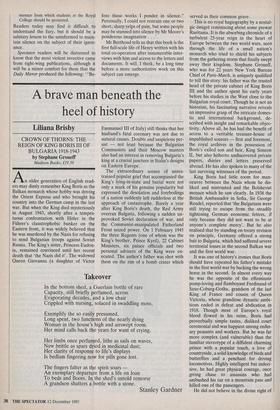The greatest sculptor of his time
Arnold Goodman
THE LIFE OF HENRY MOORE by Roger Berthoud Faber, £14.95 Henry Moore was not kind to biog- raphers. Outside his artistic career and the manifestations of genius, his private life had no special highlights that would arouse a flicker of interest in the gossip columns. The most determined investigatory jour- nalist would have found difficulty unear- thing the faintest breath of scandal, or even of personal eccentricity, justifying a men- tion at the height of the 'silly season'.
Mr Berthoud's book — long and de- tailed, carefully documented and attrac- tively written — is designed for those with a keen interest in a man whom he rightly described, at the time when he wrote it, as `the world's greatest living sculptor'. I share the view, more fittingly held, for instance, by my friend Lucian Freud, that it is a futility to attempt to describe the visual arts in words; but that is no dispar- agement of a careful and indeed fascinating biography that, furnishing full and accurate details of Henry Moore's life from cradle to grave, must complement an appreciation of his works.
Conclusions can be drawn, correctly or erroneously,from his Yorkshire birth and childhood in the humblest of homes; from his army service in the first world war; from his migration to London — never to re-establish himself in the north, notwith- standing his life-long fidelity to Yorkshire; from his teaching experiences, and indeed from all the formative influences until he attained world eminence and success. All these matters are decribed in detail and faithfully by Mr Berthoud. He is particu- larly felicitous in describing the most im- portant influence in Henry's life — his marriage to Irina — and the deep love which enabled her to provide steady but firm counsel and support throughout their 57 years together.
My slender claims to write a review of this book are that I had been a friend of Henry since 1965 when, presiding at my first meeting as Chairman of the Arts Council, I found him a well-established member of that Council. His contribution to the proceedings during his period of membership was anything but vocal. He hardly said a word and clearly had no special interest in artistic administration. But when he was a member of a delegation to the London County Council to insist that the Hayward Gallery — in process of erection — should have at least some natural light, he displayed a side of his character that to me was a revelation. Skilfully marshalled arguments, based on unarguable authority, left the building owners totally defeated and bound to effect a necessary change — although, as it turned out, probably an inadequate one.
Wisely, Henry never discussed artistic matters with me. He would have rated my opinion on them rather lower than I would have rated his on legal matters. But he never hesitated to express a view if I asked him about a particular artist and, although hot irons would not have induced him to express a favourable view where it did not exist, his judgments were always as gener- ous as could be.
The biography provides an interesting account of the feature of Henry's life that has some tabloid interest: the desperate hostility to his work displayed by adversar- ies around the 1930s, led by a — happily — now extinct Morning Post. A specimen comment from the Morning Post is:
We apologise for publishing even a photo- graph of the least objectionable of Mr Henry Moore's statues . . . for surely most people would hold it to be revolting as a representa- tion . . . and ignoble as a work of Art. Frankly we think that Mr Moore's work is a menace from which students at the Royal College should be protected.
Readers today may find it difficult to understand the fury, but it should be a salutary lesson to the uninformed to main- tain silence on the subject of their ignor- ance.
Spectator readers will be distressed to know that the most violent invective came from right-wing publications, although it will be a minor comfort for them that the Daily Mirror produced the following: "Be- fore these works I ponder in silence." Personally, I could not restrain one or two short, sharp yelps of pain, but some people may be stunned into silence by Mr Moore's ponderous imagination . .
Mr Berthoud tells us that this book is the first full-scale life of Henry written with his total co-operation after innumerable inter- views with him and access to the letters and documents. It will, I think, be a long time before a more authoritative work on this subject can emerge.



























































 Previous page
Previous page